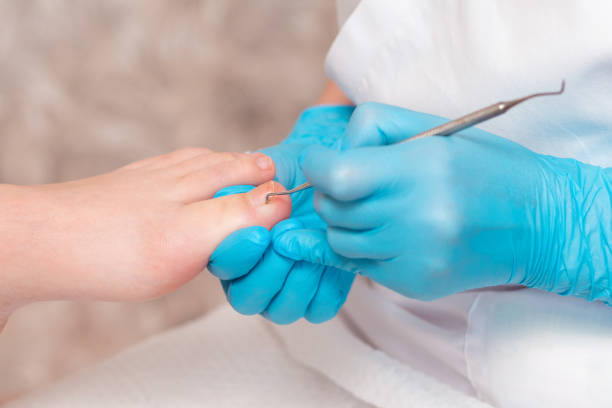Ingrown toenails develop when the corner or side of a nail digs into the soft flesh surrounding it. This is especially common in the big toe and can cause pain, swelling, redness and a potential infection.
Conservative treatment can include soaking the foot in warm water 3-4 times a day and gently pushing away the ingrown toenail edge with a cotton swab. It’s also recommended to take anti-inflammatories or acetaminophen to relieve pain and reduce swelling.

Home Treatment
After undergoing ingrown toenail surgery Brisbane North, you should follow some simple home treatment instructions to speed up the recovery process. You should also keep in mind that an ingrown toenail can come back if it’s not treated properly. The most common way to treat ingrown toenails is to trim your nails straight across with sterile clippers, and avoid cutting into the corners. You should also wear shoes that fit well, and try not to rip or tear your nails. If the pain persists, you should visit a foot and ankle specialist to receive professional ingrown nail surgery.
The first step of the surgical procedure is to inject a local anesthetic into the affected toe. Once the anesthetic is working, your doctor can safely and painlessly remove the painful part of the nail. Then, the doctor may use a heated electrical device called a cautery or an acidic solution such as phenol to stop the nail from growing where the ingrown portion was removed. This prevents the nail from bleeding and may kill the matrix area so the ingrown toenail won’t grow again.
Then your physician will put a non-adherent dressing and some sterile gauze on the toe. They will recommend you rest the leg as much as possible to reduce swelling and bleeding. They may also suggest over-the-counter medications such as acetaminophen and ibuprofen to help with the pain. They may also recommend soaking the toe in warm water and Epsom salts.
Anti-Inflammatory Drugs
In some cases, ingrown toenails are so painful and so infected that they need to be treated with a course of antibiotics and a surgical procedure. This can be done by a podiatrist, a doctor who treats problems of the lower legs and feet.
The doctor will clean and numb your toe with an injection of anesthetic before removing the ingrown section of nail. The doctor may also use a heated device called cautery or an acidic solution such as phenol to destroy the area where the ingrown section of the nail is so that it can’t grow back. The doctor will usually put a small bandage over the toe to protect it while it heals.
You will need to keep the toe elevated while it is healing. Soak the toe in warm water or Epsom salt and apply an antibiotic ointment several times a day. You should also wear shoes that fit well and don’t place pressure on your toes.
Partial nail avulsion is the most common surgery for ingrown toenails. The doctor will remove the ingrown section of the toenail and a small amount of the surrounding tissue. The toe will be bandaged and should not be removed for 48 hours. Then, the toe can be soaked and the bandage can be removed. After the toe is dry, you can soak it again a few times a day.
Partial Nail Removal
Partial nail removal, also known as matrixectomy or matricoblation, is one of the most commonly performed operations for ingrown toenails. The procedure is painless and takes a few minutes. A local anesthetic is used to numb the toe and the ingrown edges of the toenail are cut away from the nail plate. A chemical called phenol is then applied to the toenail. This prevents the toenail from growing back and becoming ingrown again. If the ingrown toenail is infected, a course of antibiotics may be prescribed and any pus drained.
Simple partial nail avulsion with phenolisation has been shown to be effective in the treatment of stage 1 ingrown toenails, but this is not a cure-all. It is only successful in eradicating the condition in about 30 percent of patients.
In addition to removing the ingrown edge of the toenail, the surgeon will treat the base of the nail, known as the matrix. This is done using cotton swabs that are dipped in a chemical solution and held against the exposed matrix for a few seconds. This scars the matrix so that the toenail cannot grow on this side again and usually results in a narrower toenail.
The toe is then treated with antibiotic ointment and a bulky dressing is placed on the foot. The patient is instructed to keep the area clean and to apply ointment daily, but to avoid any compression over the wound. In addition, ibuprofen and acetaminophen are encouraged for postoperative pain management. A pathology evaluation is rarely required unless there is an abnormal growth or suspected malignancy.
Full Nail Removal
In some cases, removing the nail and preventing it from growing back is the only option. This is known as matrixectomy and is a relatively simple procedure that can be performed in the doctor’s office with local anesthesia. It involves removing the troublesome section of the toenail and using a chemical called phenol to destroy the matrix that would otherwise produce a new nail.
Ingrown toenails, also known as onychocryptosis, occur when the edge of a toenail grows down into and pierces the side of the nail groove (lateral nail fold). The resulting inflammation often causes pain, redness, swelling, drainage, and infection. The condition most commonly affects the big toe and is caused by improper trimming, sports involving a lot of toe impact, ill-fitting shoes, or nail deformities.
If you’re experiencing painful toenails, it’s important to see a podiatrist or foot specialist for treatment. It’s best to make an appointment for an evaluation, so your doctor can take a look at the extent of the damage and recommend the right course of action. Remember, you can prevent ingrown toenails from forming in the first place by keeping your nails properly trimmed and not picking at them or pushing down on them. Also, try to wear comfortable shoes that fit well and don’t rub against your feet. If you have a chronic condition like diabetes, keep your feet dry and avoid getting them wet.





